Multiscale Evaluation and Error Characterization of HY-2B Fused Sea Surface Temperature Data
Abstract
1. Introduction
2. Materials and Methods
2.1. Study Area
2.2. Datasets
2.2.1. HY-2B SST
2.2.2. MWIR SST
2.2.3. In Situ Observation Data
2.2.4. ERA5 Reanalysis Data
2.3. Methods
2.3.1. Data Matching and Quality Control
2.3.2. Comparison Methods
2.3.3. Statistical Indicators and Analysis
2.3.4. Extended Triple Collocation (ETC)
3. Results
3.1. Comparison with In Situ SST
3.2. Comparison of Fusion SST Products
3.3. ETC Analysis Results
4. Discussion
4.1. Time-Dependent Characteristics of SST Errors
4.2. SST Error Characteristics at Different Latitudes
4.3. Changes in SST Error Characteristics at Different Temperatures
4.4. Variations in SST Error Under Wind Speed Influence
4.5. Variations in SST Error Under Columnar Water Vapor Conditions
4.6. Impact of Cloud Liquid Water Content on SST Error Characteristics
5. Conclusions
Author Contributions
Funding
Data Availability Statement
Acknowledgments
Conflicts of Interest
References
- Pisano, A.; Marullo, S.; Artale, V.; Falcini, F.; Yang, C.; Leonelli, F.E.; Santoleri, R.; Buongiorno Nardelli, B. New evidence of Mediterranean climate change and variability from sea surface temperature observations. Remote Sens. 2020, 12, 132. [Google Scholar] [CrossRef]
- Ateweberhan, M.; McClanahan, T.R. Relationship between historical sea-surface temperature variability and climate change–induced coral mortality in the western Indian Ocean. Mar. Pollut. Bull. 2010, 60, 964–970. [Google Scholar] [CrossRef]
- Enfield, D.B.; Mestas-Nuñez, A.M. Multiscale variabilities in global sea surface temperatures and their relationships with tropospheric climate patterns. J. Clim. 1999, 12, 2719–2733. [Google Scholar] [CrossRef]
- Ruela, R.; Sousa, M.C.; de Castro, M.; Dias, J.M. Global and regional evolution of sea surface temperature under climate change. Glob. Planet. Change 2020, 190, 103190. [Google Scholar] [CrossRef]
- O’Carroll, A.G.; Armstrong, E.M.; Beggs, H.M.; Bouali, M.; Casey, K.S.; Corlett, G.K.; Dash, P.; Donlon, C.J.; Gentemann, C.L.; Høyer, J.L.; et al. Observational needs of sea surface temperature. Front. Mar. Sci. 2019, 6, 420. [Google Scholar] [CrossRef]
- Hausmann, U.; Czaja, A. The observed signature of mesoscale eddies in sea surface temperature and the associated heat transport. Deep-Sea Res. Part I Oceanogr. Res. Pap. 2012, 70, 60–72. [Google Scholar] [CrossRef]
- Wang, Y.; Yu, Y.; Zhang, Y.; Zhang, H.-R.; Chai, F. Distribution and variability of sea surface temperature fronts in the South China Sea. Estuar. Coast. Shelf Sci. 2020, 240, 106793. [Google Scholar] [CrossRef]
- Tandeo, P.; Chapron, B.; Ba, S.; Autret, E.; Fablet, R. Segmentation of mesoscale ocean surface dynamics using satellite SST and SSH observations. IEEE Trans. Geosci. Remote Sens. 2014, 52, 4227–4235. [Google Scholar] [CrossRef]
- Zhang, H.; Ignatov, A. A completeness and complementarity analysis of the data sources in the NOAA in situ sea surface temperature quality monitor (iQuam) system. Remote Sens. 2021, 13, 3741. [Google Scholar] [CrossRef]
- Minnett, P.J.; Alvera-Azcárate, A.; Chin, T.M.; Corlett, G.K.; Gentemann, C.L.; Karagali, I.; Li, X.; Marsouin, A.; Marullo, S.; Maturi, E.; et al. Half a century of satellite remote sensing of sea-surface temperature. Remote Sens. Environ. 2019, 233, 111366. [Google Scholar] [CrossRef]
- Wentz, F.J.; Gentemann, C.; Smith, D.; Chelton, D. Satellite measurements of sea surface temperature through clouds. Science 2000, 288, 847–850. [Google Scholar] [CrossRef]
- Biswas, S.K.; Gopalan, K.; Jones, W.L.; Bilanow, S. Correction of time-varying radiometric errors in TRMM Microwave Imager calibrated brightness temperature products. IEEE Geosci. Remote Sens. Lett. 2010, 7, 851–855. [Google Scholar] [CrossRef]
- Wentz, F.J. A 17-yr climate record of environmental parameters derived from the Tropical Rainfall Measuring Mission (TRMM) Microwave Imager. J. Clim. 2015, 28, 6882–6902. [Google Scholar] [CrossRef]
- Stammer, D.; Wentz, F.; Gentemann, C. Validation of microwave sea surface temperature measurements for climate purposes. J. Clim. 2003, 16, 73–87. [Google Scholar] [CrossRef]
- Qian, G. China launches HY-2B satellite atop a LM-4B. Aerosp. China 2018, 19, 57. [Google Scholar]
- Liu, S.B.; Cui, X.D.; Li, Y.N.; Jin, X.; Zhou, W.; Dang, H.X.; Li, H. Retrieval of sea surface temperature from the scanning microwave radiometer aboard HY-2B. Int. J. Remote Sens. 2021, 42, 4621–4643. [Google Scholar] [CrossRef]
- Zhou, W.; Lin, M.; Yin, X.; Ma, X.; Huang, L.; Wang, S.; Ma, C.; Zhang, Y. Preliminary estimate of sea surface temperature from the scanning microwave radiometer onboard HY-2B satellite. In Proceedings of the IGARSS 2019—2019 IEEE International Geoscience and Remote Sensing Symposium, Yokohama, Japan, 28 July–2 August 2019; pp. 8173–8176. [Google Scholar] [CrossRef]
- Zhang, L.; Yu, H.; Wang, Z.; Yin, X.; Yang, L.; Du, H.; Li, B.; Wang, Y.; Zhou, W. Evaluation of the initial sea surface temperature from the HY-2B scanning microwave radiometer. IEEE Geosci. Remote Sens. Lett. 2021, 18, 137–141. [Google Scholar] [CrossRef]
- Dash, P.; Ignatov, A.; Martin, M.; Donlon, C.; Brasnett, B.; Reynolds, R.W.; Banzon, V.; Beggs, H.; Cayula, J.; Chao, Y.; et al. Group for High Resolution Sea Surface Temperature (GHRSST) analysis fields inter-comparisons—Part 2: Near real time web-based level 4 SST Quality Monitor (L4-SQUAM). Deep Sea Res. Part II Top. Stud. Oceanogr. 2012, 77–80, 31–43. [Google Scholar] [CrossRef]
- Casey, K.S.; Adamec, D. Sea surface temperature and sea surface height variability in the North Pacific Ocean from 1993 to 1999. J. Geophys. Res. 2002, 107, 14-1–14-12. [Google Scholar] [CrossRef]
- Werb, B.E.; Rudnick, D.L. Remarkable changes in the dominant modes of North Pacific sea surface temperature. Geophys. Res. Lett. 2023, 50, e2022GL101078. [Google Scholar] [CrossRef]
- Xu, F.; Ignatov, A. In situ SST Quality Monitor (iQuam). J. Atmos. Ocean. Technol. 2014, 31, 164–180. [Google Scholar] [CrossRef]
- Wang, H.; Lin, M.; Ma, C.; Yin, X.; Guan, L. Evaluation of sea surface temperature from HY-1C data. In Proceedings of the IGARSS 2020—2020 IEEE International Geoscience and Remote Sensing Symposium, Waikoloa, HI, USA, 26 September–2 October 2020; pp. 5897–5900. [Google Scholar] [CrossRef]
- Tu, Q.; Hao, Z. Validation of sea surface temperature derived from Himawari-8 by JAXA. IEEE J. Sel. Top. Appl. Earth Obs. Remote Sens. 2020, 13, 448–459. [Google Scholar] [CrossRef]
- Chen, Y.; Qu, L.; Guan, L. Evaluation of NOAA/AVHRR sea surface temperature at full HRPT resolution in the Northwest Pacific Ocean. J. Ocean Univ. China 2021, 20, 1431–1439. [Google Scholar] [CrossRef]
- Xu, F.; Ignatov, A. Error characterization in iQuam SSTs using triple collocations with satellite measurements. Geophys. Res. Lett. 2016, 43, 10826–10834. [Google Scholar] [CrossRef]
- Bell, B.; Hersbach, H.; Simmons, A.; Berrisford, P.; Dahlgren, P.; Horányi, A.; Muñoz-Sabater, J.; Nicolas, J.; Radu, R.; Schepers, D.; et al. The ERA5 global reanalysis: Preliminary extension to 1950. Q. J. R. Meteorol. Soc. 2021, 147, 4186–4227. [Google Scholar] [CrossRef]
- Hersbach, H.; Bell, B.; Berrisford, P.; Hirahara, S.; Horányi, A.; Muñoz-Sabater, J.; Nicolas, J.; Peubey, C.; Radu, R.; Schepers, D.; et al. The ERA5 global reanalysis. Q. J. R. Meteorol. Soc. 2020, 146, 1999–2049. [Google Scholar] [CrossRef]
- Gentemann, C.L.; Wentz, F.J.; Mears, C.A.; Smith, D.K. In situ validation of Tropical Rainfall Measuring Mission microwave sea surface temperatures. J. Geophys. Res. Oceans 2004, 109, C04021. [Google Scholar] [CrossRef]
- Gentemann, C.L.; Hilburn, K.A. In situ validation of sea surface temperatures from the GCOM-W1 AMSR2 RSS calibrated brightness temperatures. J. Geophys. Res. Oceans 2015, 120, 3567–3585. [Google Scholar] [CrossRef]
- Zhao, Y.; Zhu, J.; Lin, M.; Chen, C.; Huang, X.; Wang, H.; Zhang, Y.; Peng, H. Assessment of the initial sea surface temperature product of the scanning microwave radiometer aboard on HY-2 satellite. Acta Oceanol. Sin. 2014, 33, 109–113. [Google Scholar] [CrossRef]
- Woo, H.-J.; Park, K.-A. Inter-comparisons of daily sea surface temperatures and in-situ temperatures in the coastal regions. Remote Sens. 2020, 12, 1592. [Google Scholar] [CrossRef]
- Kennedy, J.J. A review of uncertainty in in situ measurements and data sets of sea surface temperature. Rev. Geophys. 2014, 52, 1–32. [Google Scholar] [CrossRef]
- Kennedy, J.J.; Rayner, N.A.; Smith, R.O.; Parker, D.E.; Saunby, M. Reassessing biases and other uncertainties in sea surface temperature observations measured in situ since 1850: 1. Measurement and sampling uncertainties. J. Geophys. Res. Atmos. 2011, 116, D14103. [Google Scholar] [CrossRef]
- Dong, S.; Gille, S.T.; Sprintall, J.; Gentemann, C. Validation of the Advanced Microwave Scanning Radiometer for the Earth Observing System (AMSR-E) sea surface temperature in the Southern Ocean. J. Geophys. Res. Oceans 2006, 111, C04002. [Google Scholar] [CrossRef]
- Donlon, C.J.; Minnett, P.J.; Gentemann, C.; Nightingale, T.J.; Barton, I.J.; Ward, B.; Murray, M.J. Toward improved validation of satellite sea surface skin temperature measurements for climate research. J. Clim. 2002, 15, 353–369. [Google Scholar] [CrossRef]
- Minnett, P.J. Radiometric measurements of the sea-surface skin temperature: The competing roles of the diurnal thermocline and the cool skin. Int. J. Remote Sens. 2003, 24, 5033–5047. [Google Scholar] [CrossRef]
- Fairall, C.W.; Bradley, E.F.; Godfrey, J.S.; Wick, G.A.; Edson, J.B.; Young, G.S. Cool-skin and warm-layer effects on sea surface temperature. J. Geophys. Res. Oceans 1996, 101, 1295–1308. [Google Scholar] [CrossRef]
- Liu, Z.; Yang, M.; Qu, L.; Guan, L. Regional study on the oceanic cool skin and diurnal warming effects: Observing and modeling. Remote Sens. 2023, 15, 3814. [Google Scholar] [CrossRef]
- Stoffelen, A. Toward the true near-surface wind speed: Error modeling and calibration using triple collocation. J. Geophys. Res. Oceans 1998, 103, 7755–7766. [Google Scholar] [CrossRef]
- Gruber, A.; Su, C.-H.; Zwieback, S.; Crow, W.; Dorigo, W.; Wagner, W. Recent advances in (soil moisture) triple collocation analysis. Int. J. Appl. Earth Obs. Geoinf. 2016, 45, 200–211. [Google Scholar] [CrossRef]
- Draper, C.; Reichle, R.; de Jeu, R.; Naeimi, V.; Parinussa, R.; Wagner, W. Estimating root mean square errors in remotely sensed soil moisture over continental scale domains. Remote Sens. Environ. 2013, 137, 288–298. [Google Scholar] [CrossRef]
- Peng, J.; Misra, S.; Piepmeier, J.R.; Dinnat, E.P.; Yueh, S.H.; Meissner, T.; Vine, D.M.L.; Shelton, K.E.; Freedman, A.P.; Dunbar, R.S.; et al. Soil Moisture Active/Passive (SMAP) L-Band Microwave Radiometer post-launch calibration upgrade. IEEE J. Sel. Top. Appl. Earth Obs. Remote Sens. 2019, 12, 1647–1657. [Google Scholar] [CrossRef]
- Hong, Z.; Moreno, H.A.; Li, Z.; Li, S.; Greene, J.S.; Hong, Y.; Alvarez, L.V. Triple collocation of ground-, satellite- and land surface model-based surface soil moisture products in Oklahoma—Part I: Individual product assessment. Remote Sens. 2022, 14, 5641. [Google Scholar] [CrossRef]
- Li, C.; Tang, G.; Hong, Y. Cross-evaluation of ground-based, multi-satellite and reanalysis precipitation products: Applicability of the triple collocation method across mainland China. J. Hydrol. 2018, 562, 71–83. [Google Scholar] [CrossRef]
- Wild, A.; Chua, Z.-W.; Kuleshov, Y. Triple collocation analysis of satellite precipitation estimates over Australia. Remote Sens. 2022, 14, 2724. [Google Scholar] [CrossRef]
- Hoareau, N.; Portabella, M.; Lin, W.; Ballabrera-Poy, J.; Turiel, A. Error characterization of sea surface salinity products using triple collocation analysis. IEEE Trans. Geosci. Remote Sens. 2018, 56, 5160–5168. [Google Scholar] [CrossRef]
- Caires, S.; Sterl, A. Validation of ocean wind and wave data using triple collocation. J. Geophys. Res. Oceans 2003, 108, 3098. [Google Scholar] [CrossRef]
- McColl, K.A.; Vogelzang, J.; Konings, A.G.; Entekhabi, D.; Piles, M.; Stoffelen, A. Extended triple collocation: Estimating errors and correlation coefficients with respect to an unknown target. Geophys. Res. Lett. 2014, 41, 6229–6236. [Google Scholar] [CrossRef]
- Saha, K.; Dash, P.; Zhao, X.; Zhang, H.-m. Error estimation of Pathfinder version 5.3 Level-3C SST using extended triple collocation analysis. Remote Sens. 2020, 12, 590. [Google Scholar] [CrossRef]
- Cao, M.; Mao, K.; Yan, Y.; Shi, J.; Wang, H.; Xu, T.; Fang, S.; Yuan, Z. A new global gridded sea surface temperature data product based on multisource data. Earth Syst. Sci. Data 2021, 13, 2111–2134. [Google Scholar] [CrossRef]
- Hosoda, K.; Kawamura, H. Seasonal variation of space/time statistics of short-term sea surface temperature variability in the Kuroshio region. J. Oceanogr. 2005, 61, 709–720. [Google Scholar] [CrossRef]
- Wu, X.; Xiao, Q.; Wen, J.; You, D. Direct comparison and triple collocation: Which is more reliable in the validation of coarse-scale satellite surface albedo products. J. Geophys. Res. Atmos. 2019, 124, 5198–5213. [Google Scholar] [CrossRef]
- Wu, X.; Lu, G.; Wu, Z.; He, H.; Scanlon, T.; Dorigo, W. Triple collocation-based assessment of satellite soil moisture products with in situ measurements in China: Understanding the error sources. Remote Sens. 2020, 12, 2275. [Google Scholar] [CrossRef]
- Liu, P.; Zhao, Y.; Zhou, W.; Wang, S. Evaluation of HY-2B SMR sea surface temperature products from 2019 to 2024. Remote Sens. 2025, 17, 300. [Google Scholar] [CrossRef]
- Merchant, C.J.; Le Borgne, P. Retrieval of sea surface temperature from space based on modeling of infrared radiative transfer: Capabilities and limitations. J. Atmos. Ocean. Technol. 2004, 21, 1734–1746. [Google Scholar] [CrossRef]
- Price, J.F.; Weller, R.A.; Pinkel, R. Diurnal cycling: Observations and models of the upper ocean response to diurnal heating, cooling, and wind mixing. J. Geophys. Res. Oceans 1986, 91, 8411–8427. [Google Scholar] [CrossRef]
- Anding, D.; Kauth, R. Estimation of sea surface temperature from space. Remote Sens. Environ. 1970, 1, 217–220. [Google Scholar] [CrossRef]


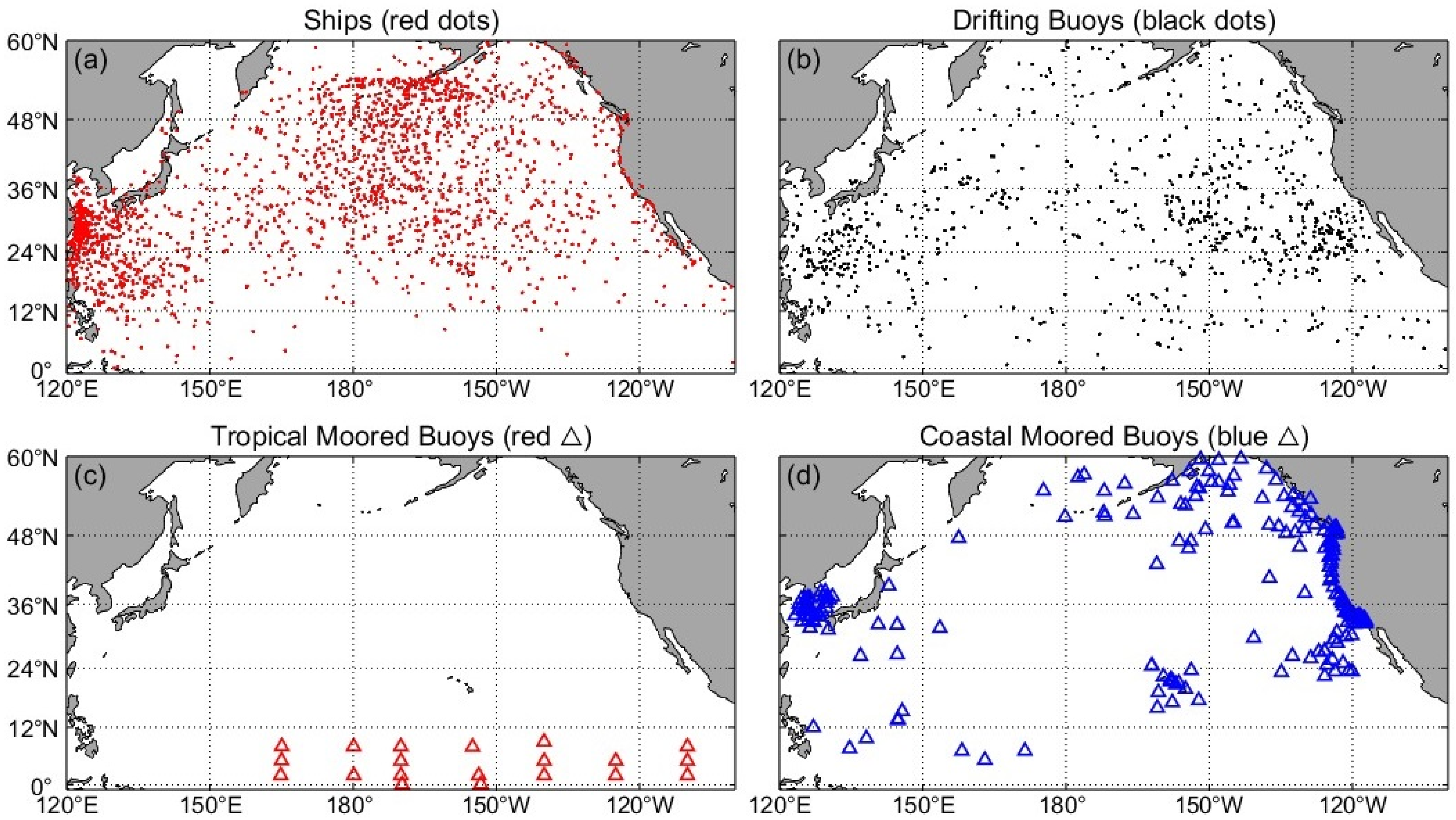
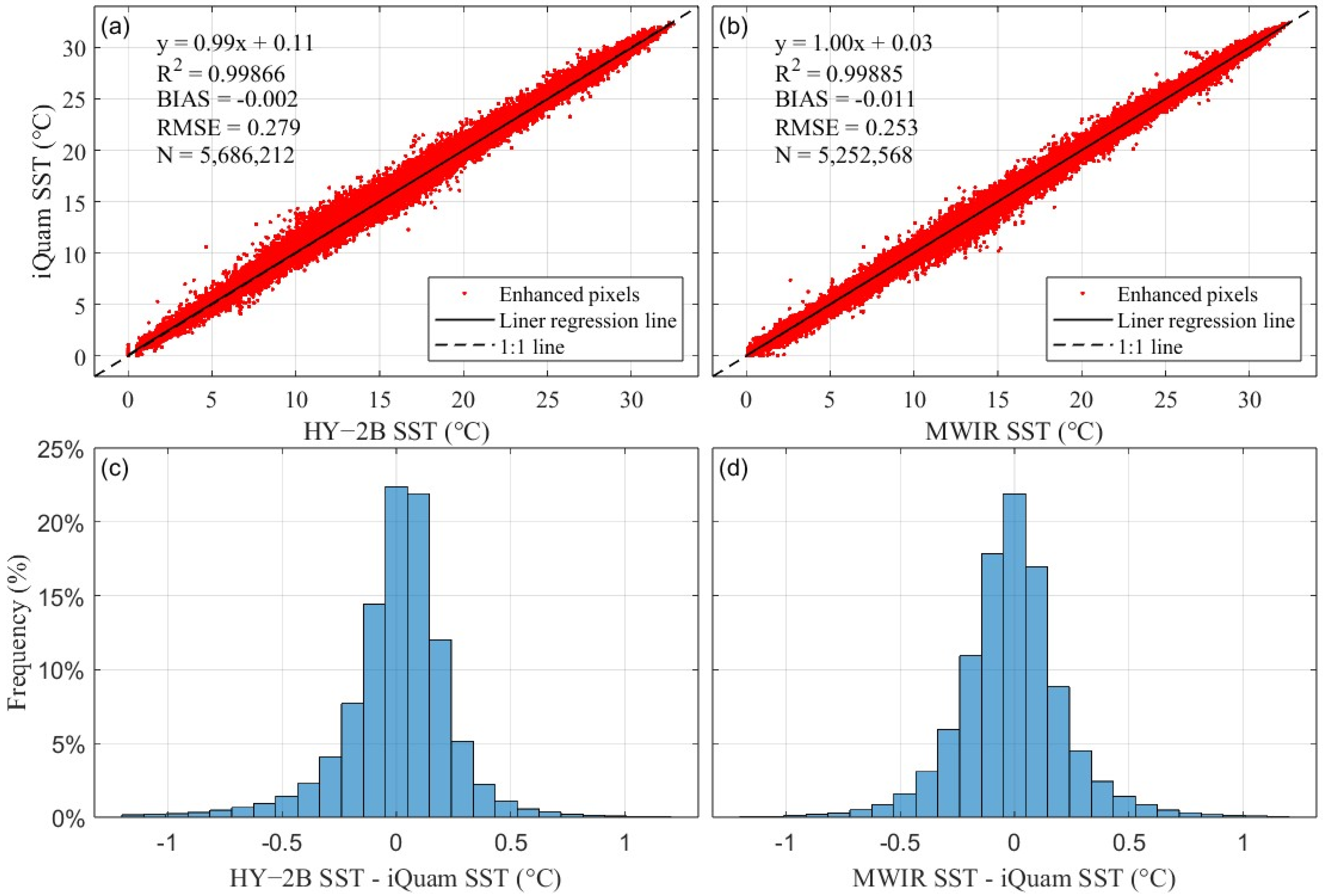

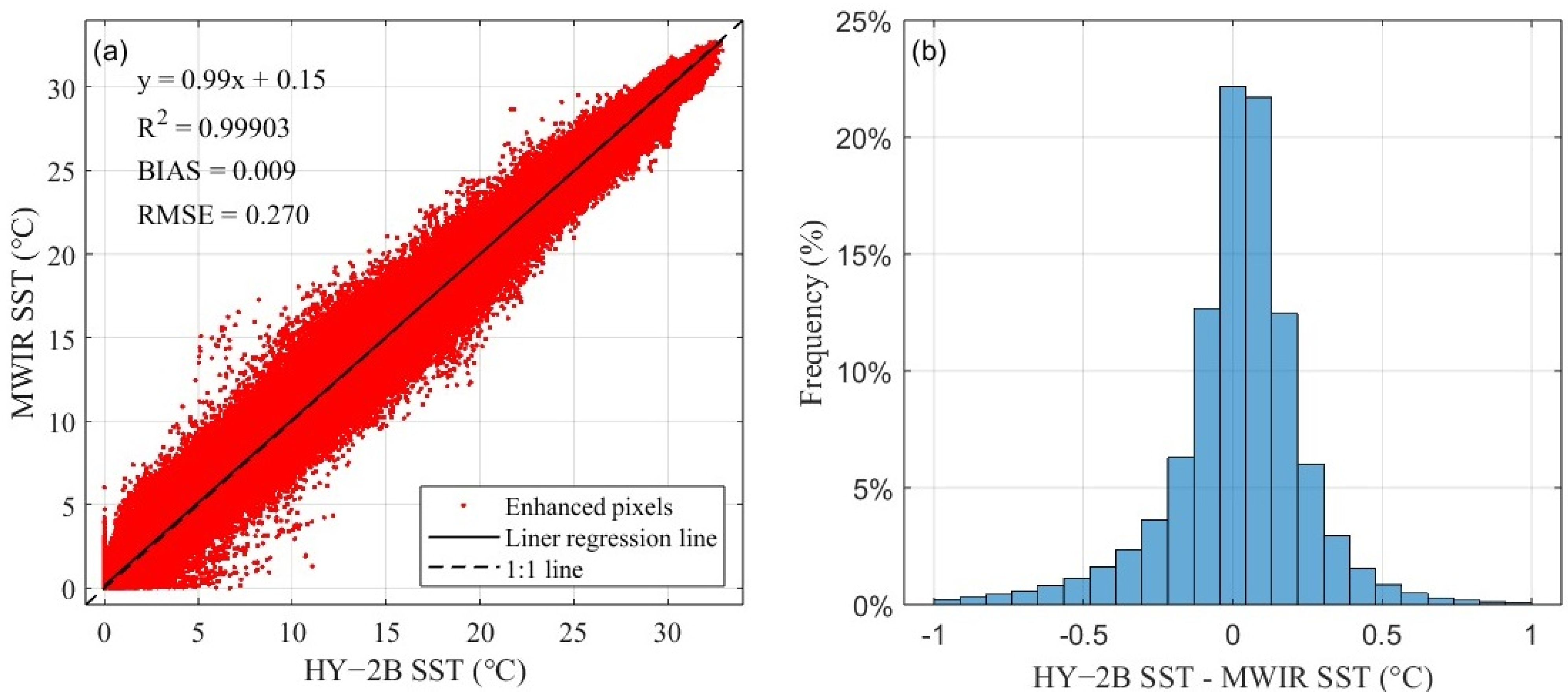

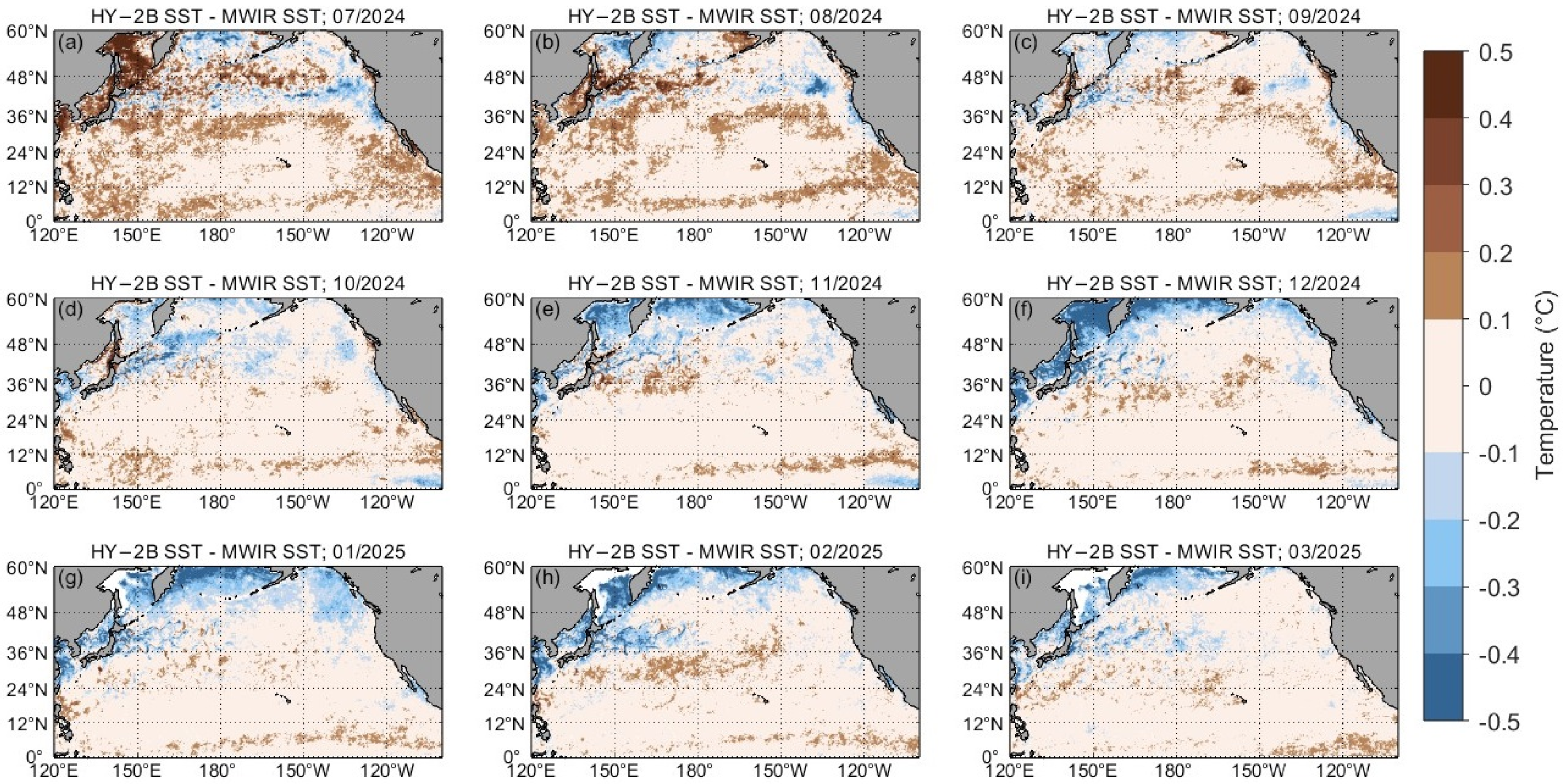
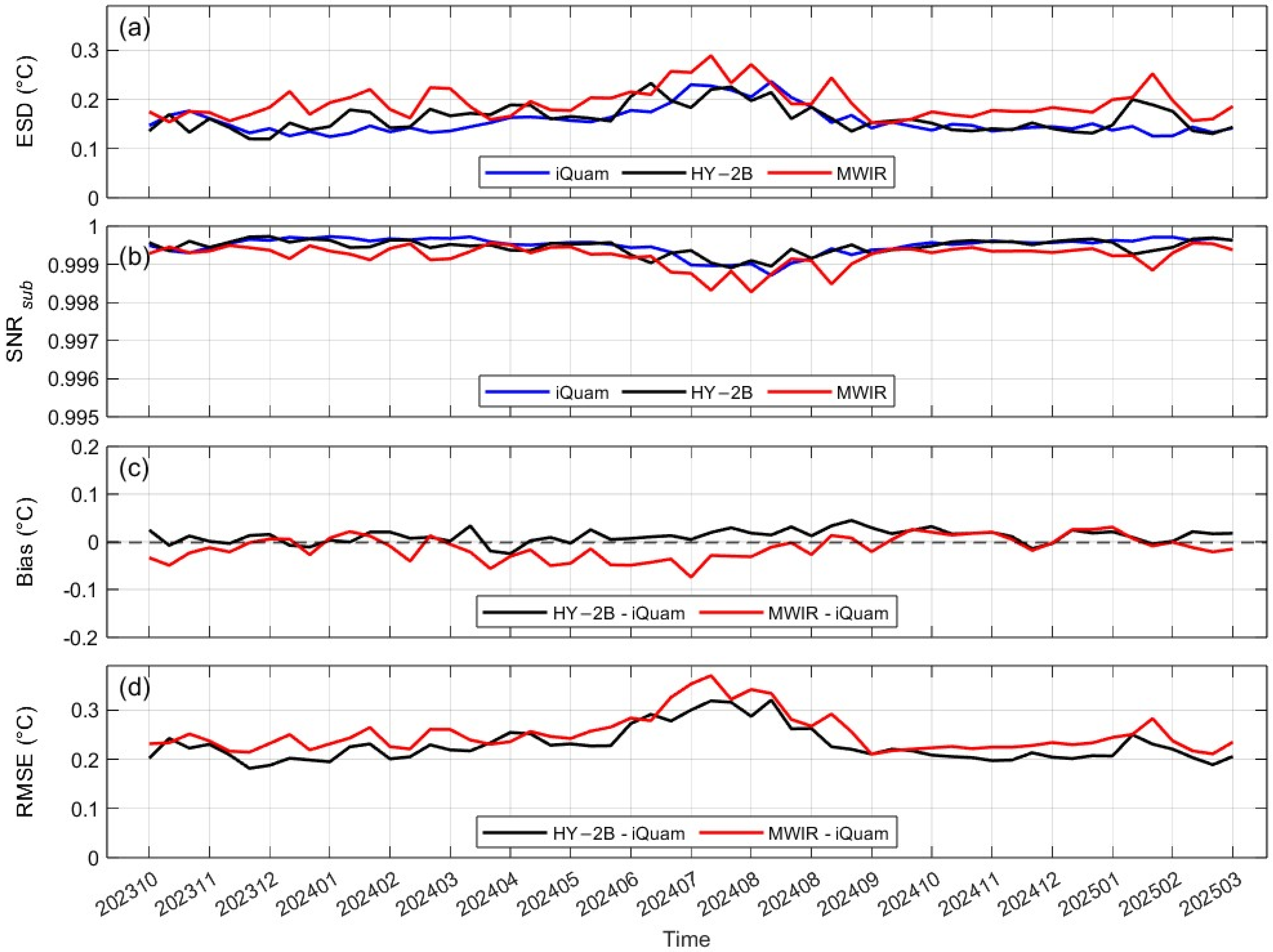
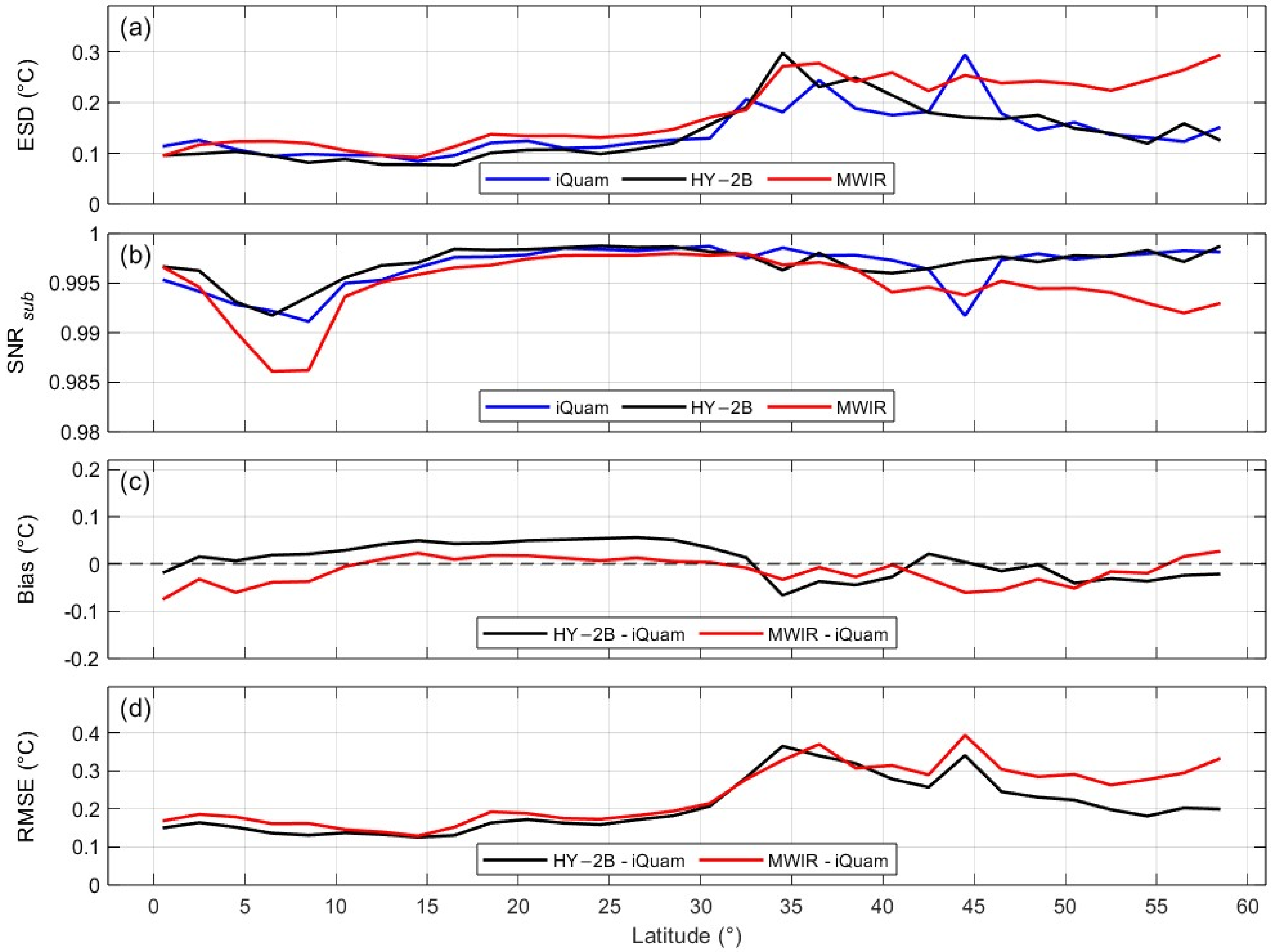

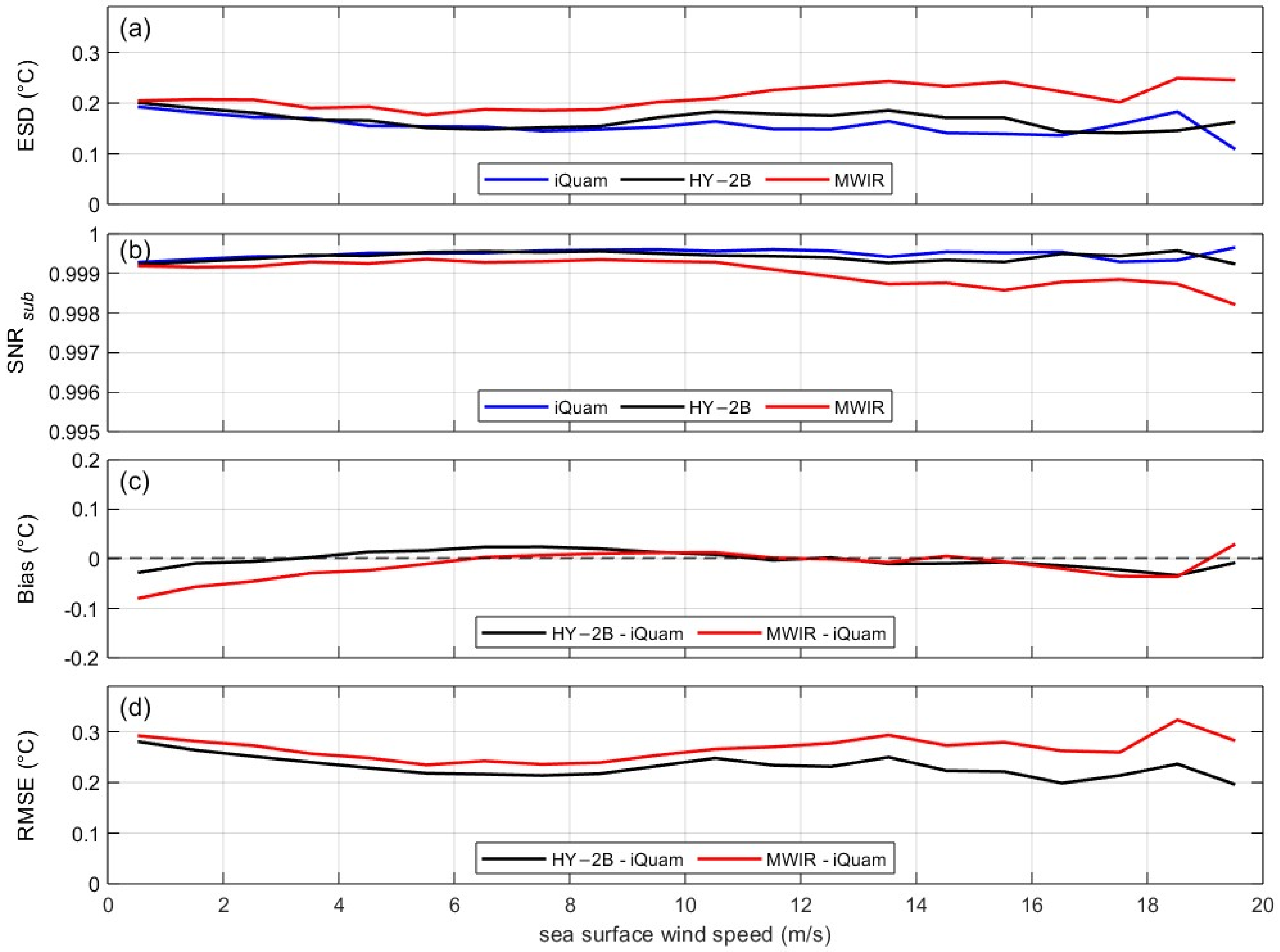


| Match Type | Indicator | iQuam Platforms | ||||
|---|---|---|---|---|---|---|
| All | Ship | Drifter | T-M | C-M | ||
| HY-2B VS iQuam | Bias (°C) | −0.002 | −0.090 | 0.042 | 0.007 | −0.063 |
| RMSE (°C) | 0.279 | 0.427 | 0.177 | 0.145 | 0.376 | |
| R-squared | 0.9987 | 0.9974 | 0.9994 | 0.9903 | 0.9969 | |
| Number | 5,686,212 | 535,382 | 3,359,875 | 126,826 | 1,663,980 | |
| MWIR VS iQuam | Bias (°C) | −0.011 | −0.017 | 0.002 | −0.057 | −0.042 |
| RMSE°C | 0.253 | 0.337 | 0.205 | 0.175 | 0.350 | |
| R-squared | 0.9989 | 0.9983 | 0.9991 | 0.9871 | 0.9970 | |
| Number | 5,252,568 | 200,550 | 3,635,475 | 135,713 | 1,280,670 | |
| Data | ETC | ALL | Ship | Drifting | T-M | C-M |
|---|---|---|---|---|---|---|
| HY-2B | ESD (°C) | 0.163 | 0.238 | 0.120 | 0.088 | 0.238 |
| 0.9996 | 0.9991 | 0.9997 | 0.9962 | 0.9986 | ||
| MWIR | ESD (°C) | 0.196 | 0.252 | 0.164 | 0.115 | 0.267 |
| 0.9993 | 0.9990 | 0.9994 | 0.9933 | 0.9983 | ||
| iQuam | ESD (°C) | 0.157 | 0.220 | 0.123 | 0.111 | 0.218 |
| 0.9996 | 0.9992 | 0.9997 | 0.9941 | 0.9988 |
Disclaimer/Publisher’s Note: The statements, opinions and data contained in all publications are solely those of the individual author(s) and contributor(s) and not of MDPI and/or the editor(s). MDPI and/or the editor(s) disclaim responsibility for any injury to people or property resulting from any ideas, methods, instructions or products referred to in the content. |
© 2025 by the authors. Licensee MDPI, Basel, Switzerland. This article is an open access article distributed under the terms and conditions of the Creative Commons Attribution (CC BY) license (https://creativecommons.org/licenses/by/4.0/).
Share and Cite
Chang, X.; Ji, L.; Zuo, G.; Wang, Y.; Ma, S.; Dou, Y. Multiscale Evaluation and Error Characterization of HY-2B Fused Sea Surface Temperature Data. Remote Sens. 2025, 17, 3043. https://doi.org/10.3390/rs17173043
Chang X, Ji L, Zuo G, Wang Y, Ma S, Dou Y. Multiscale Evaluation and Error Characterization of HY-2B Fused Sea Surface Temperature Data. Remote Sensing. 2025; 17(17):3043. https://doi.org/10.3390/rs17173043
Chicago/Turabian StyleChang, Xiaomin, Lei Ji, Guangyu Zuo, Yuchen Wang, Siyu Ma, and Yinke Dou. 2025. "Multiscale Evaluation and Error Characterization of HY-2B Fused Sea Surface Temperature Data" Remote Sensing 17, no. 17: 3043. https://doi.org/10.3390/rs17173043
APA StyleChang, X., Ji, L., Zuo, G., Wang, Y., Ma, S., & Dou, Y. (2025). Multiscale Evaluation and Error Characterization of HY-2B Fused Sea Surface Temperature Data. Remote Sensing, 17(17), 3043. https://doi.org/10.3390/rs17173043






